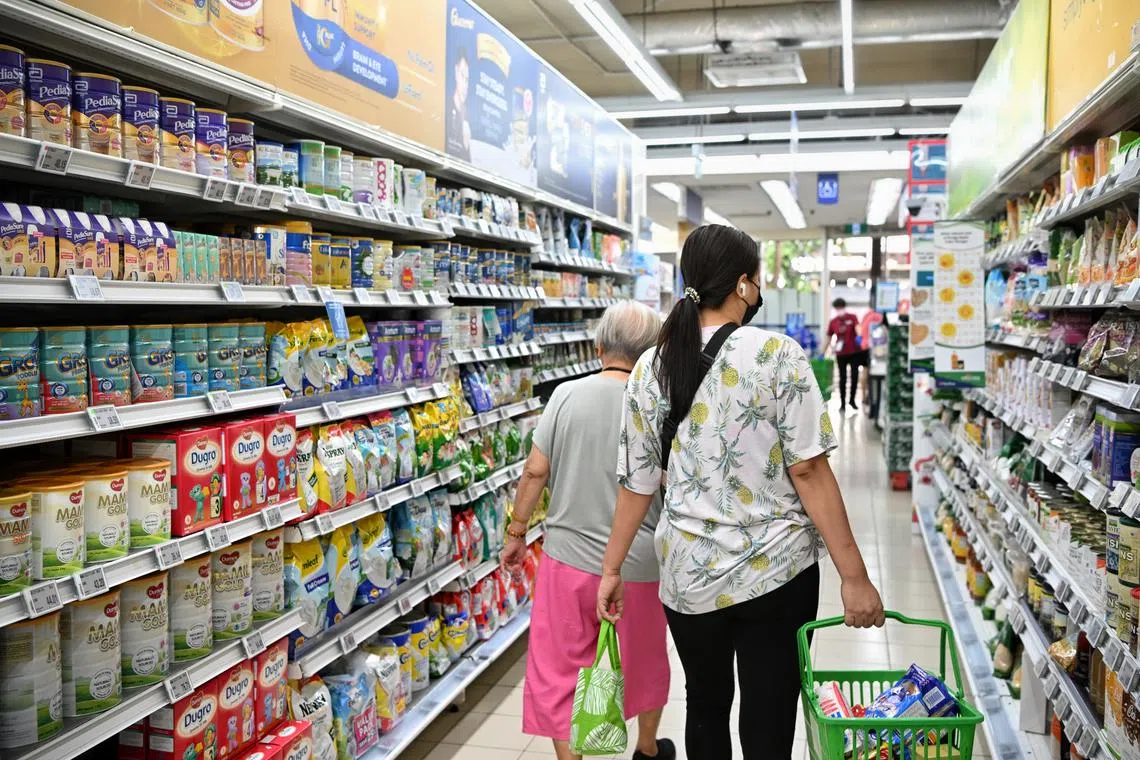Prices in S’pore seen moderating but likely to remain above pandemic levels in 2024
Sign up now: Get ST's newsletters delivered to your inbox

There are items that have, on average, seen double-digit price increases over the past 11 months.
PHOTO: ST FILE
Follow topic:
SINGAPORE – The official data says inflation is on the way down, but bank officer M. Lee feels the numbers do not reflect her experience.
The mother of four has had to increase her children’s allowances over the past year, so they can have enough for school meals and so forth. The amount for her youngest daughter has risen by 50 per cent to $15 a week, while the teenagers have seen increases of between $30 and $40, up from $20 at the start of 2023.
“The biggest expenditure for the family is food; it’s the only thing I do not scrimp on,” said Ms Lee, 40, adding: “I want to make sure my three teens and the primary school kid have enough for recess and lunch.”
Still, eating out is now reserved for very special occasions, with more home-cooked meals the norm as she tries to keep within budget.
Ms Lee’s overall perception about the rise in prices seems spot on.
While inflation in Singapore has moderated over 2023, prices are still above pre-pandemic levels and expected to remain elevated in 2024, when the impact of a 7 per cent rise in public transport fares,
Headline inflation at 3.6 per cent is still well above the 2010 to 2019 average of 1.7 per cent, while core inflation, which excludes accommodation and private transport, is at 3.2 per cent compared with the 1.5 per cent average over the nine-year period.
Headline inflation reached 6.6 per cent while core inflation hit 5.5 per cent at their peak in January.
On the surface, the average price increases of the main components in the basket of goods making up the consumer price index appear rather well contained.
These averages range between 2 per cent or so for household durables and services, and just over 6 per cent for food, transport, recreation and culture in 2023.
Dive deeper, however, and there are 10 items that have, on average, seen double-digit price increases over the past 11 months.
These include chilled poultry, eggs, seafood, flour and other non-fish seafood, which have remained at persistently high levels for the year, as have cigarettes.
Medical fees at general practitioner clinics and polyclinics were also elevated, although the price increases seemed more intense in the first half of 2023.
Meanwhile, hotels and other expenses, and charges to places of interest, saw sustained price rises in the latter half of 2023.

Economists told The Straits Times that inflationary pressures in 2023 stemmed largely from external factors, such as the reopening of economies, the continuing impact of the Ukraine-Russia conflict and post-Covid-19 supply chain disruptions and restructuring.
“These showed up mostly as a rise in prices for food, energy and imported goods,” said associate professor of economics Walter Theseira from the Singapore University of Social Sciences.
On the domestic front, the economic reopening brought with it a slew of price increases.
These included higher wages due to the tight labour market, climbing home prices as returning expatriates pushed up rents, and the unleashing of prices that had been frozen because of the pandemic.
“Ultimately, it was a case of demand running ahead of supply as the domestic economy emerged from the pandemic,” said Professor Theseira.
OCBC Bank chief economist Selena Ling said: “Businesses also grew increasingly more confident about passing on their higher costs to end-consumers as the recovery took root.”
The Israel-Hamas conflict
Still, the economists are not overly concerned about inflation in 2024, crediting the central bank’s strong Singapore dollar policy as helping offset imported inflation. This should keep the incoming price increases manageable for most of the population.
Ms Ling expects a gradual decline in prices over 2024, “partly due to (2023’s) elevated base and also because the cumulative effects of monetary policy tightening – both at home and abroad – will exert a dampening effect on imported prices”.
DBS Bank economist Chua Han Teng agreed, saying that while the path is likely to be bumpy, inflation should trend lower on average in the new year. He expects headline inflation to hit 3.5 per cent and core inflation 3.1 per cent in 2024.
“Additionally, easing domestic labour cost pressures amid cooling wage growth should translate into lower prices for services, more so for discretionary items,” he added.
Prof Theseira was more circumspect about the inflation outlook, citing “a cooling-off in key markets” juxtaposed against more persistent “geopolitical uncertainty and supply chain shifts”.
Still, he also believes that “domestically, there’s a sense that supply is finally catching up to demand, for housing and labour, while some policy factors, such as the supply of certificates of entitlement, are set to ease as well”.
Meanwhile, “the direct impact of the GST increase will be, as economic theory predicts, less than 1-to-1 because merchants with the ability to absorb or delay the increase have already declared they are doing so”, Prof Theseira noted.
He added: “It may be a marketing strategy, but it reflects the economic reality that tax hikes tend to be shared between merchants and consumers, so, effectively, the consumer doesn’t absorb the full impact of the hike.”
Ultimately, however, the GST hike
Prof Theseira said mid-career workers have the benefit of wage adjustments that can mitigate some of the impact of rising prices.
The biggest jolt of price increases will hit older workers, retirees and low-wage earners hardest as their incomes tend to be static, while consumption makes up the bulk of their spending.
That is where government assistance comes in.
Measures from Budget 2023 and September’s Cost-of-Living Support Package
However, Prof Theseira noted that wedged among the middle- to higher-income consumers is a sandwiched group that is neither able to shrug off ordinary consumer inflation, nor receive sufficient government payouts to offset their higher costs.
While this group would not be put into poverty by inflation by any means, they will still have to make some adjustments to their lifestyle, he said.
Ms Lee – who falls within this sandwiched group – concurred, adding: “This Christmas, for example, we avoided the in-demand festive fare and opted for Korean barbecue instead. And if we wait a few days after that, we can probably buy Christmas hams on discount.
“For the upcoming Chinese New Year, we’ll most likely have an Indian or Western meal instead of competing with everyone else,” she said.
Correction note: An earlier version of this story said core inflation excludes food and energy. This is incorrect. It should be excluding accommodation and private transport. We are sorry for the error.


